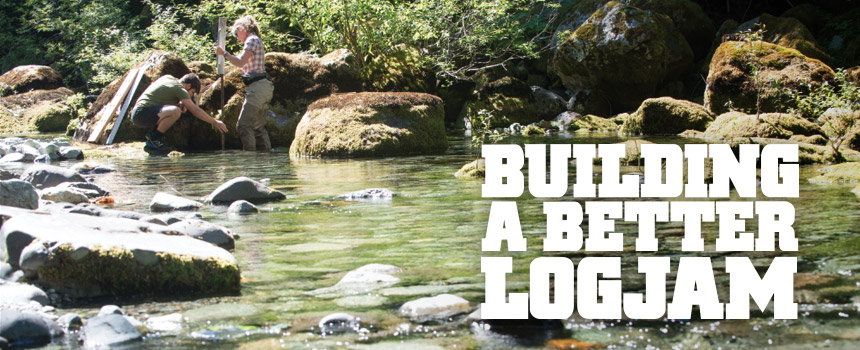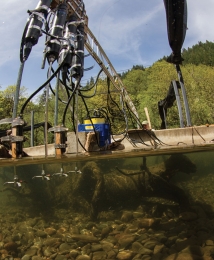Building a Better Logjam

[caption caption="Leaping up the Little North Fork of the Santiam River, OSU researcher Desirée Tullos installs a water-depth gauge for citizen scientists to monitor and record. (Photo by Lynn Ketchum.)"] [/caption]
[/caption]
Waders up to her waist, Desirée Tullos pounds a pole into the rocky bottom of the North Santiam River. Clanging metal echoes into the surrounding old growth of the Opal Creek Ancient Forest. But the pole is too wiggly to secure her water gauge. So Tullos leapfrogs to another spot in the river and screws the gauge directly into an oven-sized boulder, its line of moss foretelling higher, swifter flows to come.
Now, she waits. A nearby sign asks hikers to read the gauge and report the river’s depth to an online database. Scientists will use these data to calculate the water’s volume and velocity over time, which will help them decide how to stabilize eroding stream banks.
[caption caption="Oregon Hatchery Research Center facility manager Ryan Couture (r) and a colleague monitor steelhead in one of four experimental channels protected by netting from fish-eating birds. (Photo by Lynn Ketchum.)"] [/caption]
[/caption]
[caption caption="Underwater cameras capture the behavior of juvenile coho salmon as they negotiate man-made logjams. From this work at the Oregon Hatchery Research Center, researchers can witness how fish use water turbulence around logjams to minimize the amount of energy they use. (Photo by Desirée Tullos.)"] [/caption]
[/caption]
One option is to place hefty wood in waterways—root wads, limbs, and whole trunks—to break up stream flows and ease erosion. These are known as “engineered logjams,” said Tullos. A professor of biological and ecological engineering at Oregon State, Tullos is hunting for the best designs that will produce the intended ecological benefits.
Decades ago, woody debris was largely removed from rivers in the name of reducing floods and improving passage for boats and fish. “As they existed naturally, rivers had logs and debris stacked on top of each other,” said Tullos. “Wood removal straightened rivers and increased their velocity. Now, the scientific consensus has come back to the importance of wood in streams.”
Natural logjams play a vital role in the life of waterways throughout the world. Woody debris forces water down into the riverbed where microorganisms break down nitrogen, and phosphorus is transformed into more benign forms. Wood acts as a substrate for insects and a safe refuge for fish—a place to hide from predators and a place to retreat out of swift channels.
Natural logjams create porous dams that are ecologically and hydraulically beneficial, but how to engineer logjams for maximum benefits isn’t always clear, says Tullos. In an experiment at the Oregon Hatchery Research Center, Tullos’s team created an innovative way to observe juvenile coho salmon as they move through the woody debris. The researchers paired multiple sets of underwater GoPro cameras to track the fish and precisely measure where they went and for how long. Tullos coupled these measurements with a high-resolution mapping of water flow as it varied through space and time. With this, she created a digital 3D environment that revealed previously unobservable data—including the velocity of water at each fish’s nose and tail.
[caption caption="Researchers operate an array of acoustic doppler velocimeters, instruments that record velocities at high frequencies in three dimensions. By stitching together measurements from over 1,900 locations, they have developed a comprehensive, detailed image of the flow field. (Photo courtesy Jeremy Monroe, Freshwaters Illustrated.)"] [/caption]
[/caption]
“Normally, scientists snorkel through water to observe fish. But the scientists’ looming shadows can influence fish behavior and skew observations,” said Tullos. “Technology helps us see what fish do when we’re not looking.”
Over the past decade, the Pacific Northwest has been a testing ground for man-made logjams. Dozens have been installed by state and federal fisheries agencies and by watershed councils across the state, with varying degrees of success.
Now, Tullos is translating her data to understand how fish use water turbulence created by logjams to minimize the amount of energy they use. At first glance, her current research—adding structures to streams—runs counter to her past work—removing dams from rivers. Since joining OSU in the mid 2000s, Tullos has measured the health of rivers after dam removals in Oregon and studied the impacts of dams in Southeast Asia. Despite the literal differences—removal versus addition—Tullos considers the two areas of research to be closely related.
“Adding wood helps rivers regain the complexity that is essential for healthy aquatic ecosystems—similar to how removing dams helps rivers regain the more natural flows that are critical for healthy rivers,” said Tullos. Unlike some dams, however, logjams are not meant to be permanent. After the wood washes away or decomposes, it leaves behind a legacy of vegetation, gravel, and improved ecosystem dynamics.
“Logjams are still considered experimental, particularly outside of the Pacific Northwest,” said Tullos. “But our region is leading the country, and maybe the world, in sustainable management of rivers, and logjams are among the more important tools in our toolkit.”

